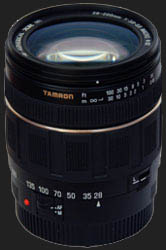They keep making these lenses better. I have the second version of the Tamron 28-200 which I have used for years with good results. The old 28-200 is a remarkably small lens for the zoom range. The earliest 28-200s from Sigma and Tamron were not very useful because they had a problem with close focusing. From the second generation on, though, they sorted that out, and in fact you can get so close you can take "macro" shots. It's not true macro, but to give you an idea you can fill the frame with an apple.
It's small
The main difference between the 28-200 XR and the older zooms is that they've somehow made it even smaller and lighter. About 30% smaller I think. It makes a big difference, especially on a small, lightweight camera. I used the 28-200XR on a Minolta Dynax 5 body, and the old, bigger 28-200 made that camera feel quite lens-heavy. With the 28-200XR, though, it felt well balanced.
It's got a whopping zoom range
28-200 is quite a long zoom range. Check out the pictures below:
28mm
200mm
They are taken from the same point in Liverpool Street station.
There's a bit of distortion
My main problem with my old 28-200 is the distortion. Put a straight line near the edge of the frame and it's usually quite obvious. The 200mm shot above is a good example. The white edge of the departure board looks curved because it's near the edge of the frame. This is just something you've got to live with and work around. I think the distortion is maybe slightly better with the new 28-200 XR than on my old 28-200.
The sharpness is good
People sometimes complain about the sharpness of these 28-200 lenses. They are actually pretty sharp lenses in my opinon, although it's easy to take blurry pictures with them, especially at the 200mm end, if you don't know what you're doing.
This shot is not a very scientific test of the new 28-200XR's sharpness but it gives you some idea. Of course whatever lens you're using will be sharper if you use a tripod. The above picture was hand-held, so as I say it's not really a brilliant test. The right-hand picture is a blow-up of just the central small window on the left hand picture, as seen in Photoshop on "actual pixels" mode. Looks pretty sharp to me, and in fact any softness is just as likely to be a result of my film scanner as the lens.
Another sharpness example
Focusing
Focusing is slower using big zooms like this than it is with prime lenses or smaller zooms. It was still perfectly acceptable with the Dynax 5, I thought, but it's something you should bear in mind. You trade off focusing speed for the extra zoom range.
Manual focusing was a bit weird, as I noticed when I was taking the shot above in Spitalfields. The focusing ring is strangely non-linear, so you turn it quite a long way with not much happening then suddenly one tiny movement makes all the difference. Think of the taps on most showers and you'll get the idea. Once you get used to it it's fine but it does make it slightly slower to focus manually at first.
Chromatic Aberration?
Chromatic Aberration means wandering colours. If you look at the blown-up picture above, the white edge of the departure board has a red tinge to it on the bottom edge and a green tinge on the top edge. As with most optical "defects" it gets worse towards the edge of the frame, and is probably worse at 200mm than at 28mm, so the above example is a worst-case scenario. It's only visible when you zoom right in, and I wouldn't really worry about it but I thought since I'd noticed it I'd point it out!
Specification
(Info below is from Jessops website)
|
XR (Extra Reflective Glass) Focal length: 28-200mm IF (Internal focusing) Angle of view: 75°-12° Optical construction: 14 elements/10 groups (3 aspherical lenses) Maximum aperture: f/3.8-5.6 Close focusing distance: 49cm Length: 75.2mm up to 126.2mm Diameter: 71mm Weight: 354g Filter size: 62mm Supplied with flower shaped lens |
The bottom line
This is a fine lens. Sharp, small and light. Pretty much everything you want in a travel lens.
The disadvantage, as with all lenses of this type, is that maximum aperture at 200mm is only f5.6. This means with 100ASA film you can only really use the 200mm end of the zoom range when your subject is in bright sunlight, otherwise you will get camera shake. With 400ASA film you have a lot more flexibility, and my recommendation for anyone travelling with this lens and wanting colour prints would be to use Fuji or Kodak 400ASA colour print film.
| [Home] | [About] | [Order Prints] | [Articles] | [World Map] |
